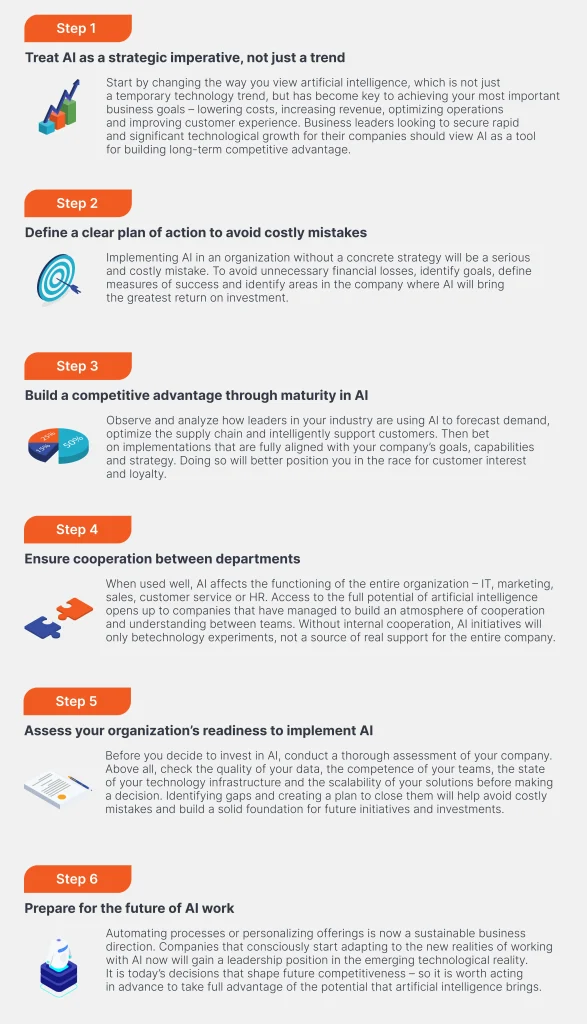In the rapidly changing realities of modern business, solutions based on artificial intelligence are becoming synonymous with increased operational efficiency. Many companies recognize the potential of AI, but only a few of them know how to effectively deal with the difficulties encountered when implementing new solutions. Success does not lie in blindly following trends, but in a planned and thoughtful alignment of technology with business goals and capabilities. Learn some tips to help your business achieve maximum return on investment.
Key takeaways from this article
- The implementation of artificial intelligence will only provide revenue growth, greater operational efficiency and a better customer experience if it is tied to the company's strategic goals. Otherwise, it will only become an expensive experiment.
- The most important step in the AI implementation process is to analyze the company's maturity in this area – key factors include data availability, team competence, infrastructure and governance mechanisms.
- The AI implementation process requires the involvement of not only the IT team, but also marketing, sales or customer service. Only in this way will AI respond to the real business problems and challenges of the entire organization.
Why does an AI strategy need to be closely aligned with a company's business goals?
Artificial intelligence opens up many new opportunities for companies, but its implementation should always serve specific business goals. Aligning AI strategies with core business objectives will ensure that AI investments contribute to revenue growth, greater operational efficiency and improved customer service. Implementing AI motivated by merely following a trend will prove to be an expensive technology experiment for the company, which will stall the company instead of accelerating growth.
The key is to strategically approach AI as a tool that will facilitate and accelerate accurate business decisions, rather than as a solution that replaces people. Hybrid models, in which AI supports data analysis and automates routine tasks, allow leaders to focus on activities that require creativity and intuition.
The most important factors in building an AI strategy
Companies wishing to prepare an optimal AI strategy must consider several key aspects and areas. The fundamental element that guarantees the effectiveness of the implementation of artificial intelligence is the availability and quality of the data the company has. Data is the fuel for analysis and tools, and if we have not taken proper care of the data we have so far, no tool – even the most advanced – will be able to bring us tangible results. Other important aspects are the technological infrastructure and the openness and competence of the teams.
The current approach to AI is moving away from a focus on algorithms, putting data – its quality, transparency and regulatory compliance – first. If you want your company to guarantee success, you need to ensure that you have cleansed and valuable data.
How to assess a company's readiness to implement AI?
A prudent step before deciding to invest in AI is an in-depth analysis of a company's readiness for transformation.
- Critical to the success of the entire endeavor is an assessment of the IT infrastructure – are the current systems powerful and flexible enough, do they need to be upgraded, and do they have sufficient computing power? Are the systems secure enough, and will it be possible to integrate AI with currently used systems?
- Another important aspect is employee competence. It is important to assess whether the organization has specialists in AI and data analytics, and whether teams are open to automation and understand for what purpose it is becoming part of the company and what it means to them.
- A third key area in assessing a company's readiness for AI deployment is compliance with regulations regarding the ethical use of artificial intelligence. The rise of responsible AI and the introduction of regulations such as the EU AI Act make it particularly important for companies to be transparent and ethical in their implementations.
Challenges of AI implementation – what can go wrong and how to deal with it?
If you want your company to benefit from having advanced AI solutions, you need to be aware of some challenges that await you.
Shortage of qualified specialists
One of the most serious problems is the perceived shortage of qualified specialists. In this case, a good solution will be to work with a trustworthy technology partner that will not only guide your company through the AI implementation process, but also strengthen your internal IT team – also in the long run.
Team resistance to change and fear of innovation
The key to realizing the full potential of both AI and future technologies is building a culture of openness to innovation. Employee resistance to change can be as big an obstacle to growth as insufficient AI infrastructure. Regular training and open dialogue about the concerns, benefits and challenges of implementing AI will build collaboration based on trust. It is important to show that AI supports people by automating routine tasks, allowing them to focus on more strategic activities.
Insufficient flexibility of solutions
Implementing AI requires systems that easily and quickly adapt to changing needs – without committing additional resources. Outdated and neglected technologies drastically limit the ability to integrate new solutions – without which a company will sooner or later lose its competitiveness. Thoughtful investment in a flexible IT architecture creates an excellent foundation for implementing innovation and easily adapting AI to rapidly changing market conditions.
One way to safely bypass the most serious pitfalls of AI implementation is to be supported by an experienced technology partner. Such cooperation will not only effectively fill the competence gaps in the team, but will also help build a culture of openness to innovation and provide the right tools and flexible IT infrastructure. A trusted partner provides the organization with comprehensive support, both strategic and operational – from consulting and training the team, to the implementation of solutions adapted to integration with AI, to ongoing technological support.
How to build an effective AI strategy in a company step by step
Implementing artificial intelligence is not just a matter of technology, but more importantly of strategically aligning it with business goals. To avoid costly mistakes and maximize ROI, it's worth approaching AI implementation in a structured way. Here are key steps that will help a company effectively plan and implement AI solutions:

Conclusion
Reaping tangible benefits from digital transformation and artificial intelligence requires a company to have a well-thought-out strategy and closely align the technology with business goals. Without proper preparation in terms of infrastructure, data quality and team competence, AI implementation will be little more than an expensive experiment. An effective and safe path to optimization is to work with an experienced technology partner who will not only fill the gaps in the IT team, but also provide support in planning, implementing and integrating AI into existing systems. By working together in this way, large and medium-sized companies can make a cost-effective transformation without the risk of costly mistakes.



